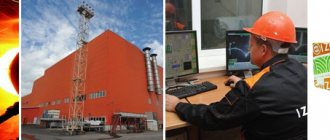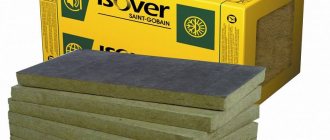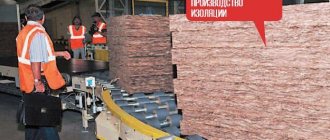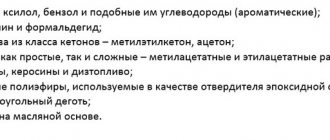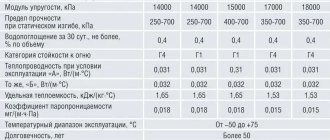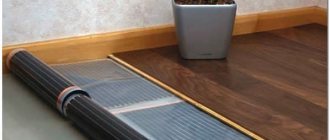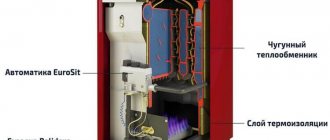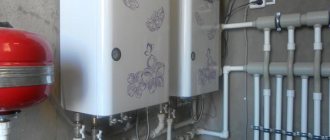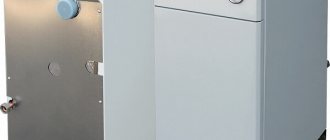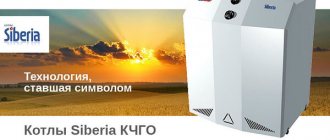Since the beginning of the 21st century, a company called ISOROC began to produce and produce mineral wool slabs, pierced mats, as well as rolls, which include gabbro-basalt raw materials. Recently, heat insulators from the Isorok company have confidently gained a foothold in the market of insulation products that have an average price. And every year it is gaining more and more popularity.
Products of the Isorok company
The use of Isorok products makes it possible to increase the thermal resistance of structures intended for fencing. Improves the soundproofing properties of objects. The fire hazard level of the structure becomes significantly lower. And the load on the base of the structure (foundation) is reduced. Thanks to the use of thermal insulation products from this manufacturer, the humidity conditions become better.
The products of the manufacturer Isorok are used for residential, non-residential and industrial buildings. The materials are widely used in various structural components (walls, roofs, ceilings, ventilation shafts, etc.).
Additional accessories are sold. Supporting materials are:
- Membranes that have vapor barrier parameters.
- Films with waterproofing properties.
- Mounting tapes.
All Isorok products have appropriate sanitary and fire safety certificates. Let's look at the product descriptions.
Specifications
Technical characteristics of insulation
Let's consider the technical characteristics of insulation from the manufacturer Isorok. Pay attention to the table. Here are presented materials from Izorok, which have different densities.
| Products | Isolite - L | Isolite | Isolite Lux | Isovent - L | Isovent | Izokor - C | Izokor - K | Isoflor |
| Options | ||||||||
| Density, kg/m3 | 40 | 50 | 60 | 80 | 90 | 105 | 140 | 110 |
| Compressive strength at 10% deformation, not less | 10kPa | 20kPa | 25kPa | |||||
| Ultimate peel strength of layers, not less | 3kPa | 4kPa | 4kPa | |||||
| Compressibility, no more | 30% | 15% | 7% | |||||
| Elasticity, %, not less | ||||||||
| Thermal conductivity at (283±5) K | 0,036 | 0,034 | 0,034 | 0,034 | 0,034 | 0,037 | 0,038 | 0,034 |
| Thermal conductivity at (298±5) K | 0,038 | 0,036 | 0,036 | 0,036 | 0,036 | 0,038 | ||
| Water absorption, no more | 1,5% | 1,5% | 1,5% | 1,5% | 1,5% | 1,5% | 1,5% | 1,5% |
| Humidity by weight, no more | 0,5% | 0,5% | 0,5% | 0,5% | 0,5% | 0,5% | 0,5% | 0,5% |
| Organic substances by weight, no more | 2,5% | 2,5% | 2,5% | 3,5% | 4% | 4% | 4% | 4% |
| Fire hazard class | Non-flammable | Non-flammable | Non-flammable | Non-flammable | Non-flammable | Non-flammable | Non-flammable | Non-flammable |
Do-it-yourself installation of ISOROC insulation
Installation diagram of Izorok mineral wool on the facade
The general principles of working with the material consist of several simple recommendations:
— slabs of material are laid in several layers with overlapping joints, excluding cold bridges;
- protected on the warm side by a vapor barrier, and on the cold side by a waterproofing film;
— the material must be additionally secured to vertical walls to prevent slipping;
— it is necessary to provide access to remove moisture from the surface of the film by creating a ventilation gap.
Products ISOLIGHT
Scope of application of Izolight products
Izolight products (Izorok Ultralight) are slabs made from basalt wool, which has a high level of moisture resistance. A total of 3 varieties are sold, which have different densities. This product is used for residential, non-residential and industrial premises. Used for thermal insulation and sound insulation. It is a universal material, as it can be used in various fields. Thermal insulation is carried out for external and internal walls, partitions, roofing, basement and so on. Suitable for completely different types of surfaces.
Costs per square meter are 100 rubles. This is an excellent price, since it is less than similar products from Rockwool, TechnoNIKOL and others.
Installation
In order to carry out insulation work using Izorok slabs on different types of surfaces, there are rules. Many technologies require the use of waterproofing and vapor barrier so that the quality of the insulation is maintained. To ensure the best performance, ancillary products from the same company should be used.
Cement floor screed
Before you start laying the insulation, you must first remove the old floor covering, clean the screed from any dirt, seal all the cracks and crevices, level the surface and lay waterproofing materials, and then Izorok mats, which must be located close to each other so that there is not even a minimal gap. After this, laying the waterproofing layer is again required, and place a reinforcing mesh on top of it, with a cement screed on top.
If under the screed there is a room in which it is humid and warm, for example, a sauna, then it is necessary to create an additional vapor barrier, which will be located under the insulation sheets. If the bottom is damp and cold, for example, a cellar, then the vapor barrier should be on top of the insulation.
Insulation of the outer wall of a frame house
In wall structures of this type, slabs have proven themselves to be the best. The highest quality insulation is considered to be made in two layers of material. A sheathing made of wooden slats with a width of 5 cm or a metal profile should be installed on the walls. The distance should be the same as the length or width of the insulation. The installation is carried out so that the slabs located on the outside overlap the seams of the material located on the inside. The sheet is attached to mushroom screws at five points. The insulation layer located on the outside must be protected with a waterproofing and windproofing film.
Insulation of the internal wall of a frame house
Usually, even at the stage of creating the frame, the distance between the wood posts is made so as to accommodate a layer of insulation, i.e. 0.6 meters, so in this case there is no need to create a sheathing, Izorok will fit in 3 layers into ready-made niches and does not need to be attached at all.
A vapor barrier film should be secured on top, which will be tightly stretched. Although it is generally accepted that the material is environmentally friendly, if particles of mineral wool get on the skin, severe itching begins, which will not go away for a day. For this reason, we urge you to use personal protective equipment and carry out work only with rubberized gloves.
Dry insulation method
A layer of waterproofing should be laid on a wooden floor whose boards are tightly laid. Logs should be laid on top of the boards, insulation should be placed closely in the gaps. This should be done at random so that there are no gaps or cracks left.
The next layer consists of a vapor barrier, as this can prevent moisture from penetrating from the warm room into the cold layer. This should be done to ensure that the insulation is protected from moisture, because this will cause it to lose its original thermal insulation properties. After this, we create a subfloor using joists from plywood, OMB or something else at your discretion. The finishing coating should be laid over this material. This can be laminate or any other type of coating you wish.
Insulation of interfloor ceilings
Using mineral slabs, you can insulate interfloor wooden floors, and for this they are laid between the beams. It is not necessary to place a protective vapor barrier layer. But if one room is humid and the other is warm, for example, a kitchen and a bathroom, a vapor barrier layer is simply necessary. If the wet room is located on top, an additional waterproofing layer will be required.
Universal heat insulator ISOFLOOR
This material from the manufacturer Izorok contains non-flammable stone wool, which also has a high level of moisture resistance. The form of the material is presented in the form of plates. Thanks to this heat-insulating product, it is possible to reduce the amount of heat loss from various types of foundations (concrete or reinforced concrete structures, self-leveling, electric, water floors and similar structures).
The cost of this insulation product is 130 rubles per square meter.
Features of ISOROC mineral wool
Thermal insulation materials ISOROC
ISOROC mineral wool is made from natural materials, consists of fibers with air between them, and has a low thermal conductivity coefficient. The material has a high melting point, is a fire-resistant material, prevents the spread of fire and can be successfully used for installation in a boiler room or in fire-fighting structures.
The company's product range includes insulation materials of various densities made from environmentally friendly materials. Heavy slabs, thanks to the strong connection of fibers, can withstand quite significant loads and are often used to insulate flat roofs. Treatment with water-repellent compounds during production increases the water-repellent characteristics of Isorok insulation.
The disadvantages of the material include deterioration of thermal insulation when wet; during installation, it is necessary to carefully vapor-waterproof the structure. It is also possible for light grades of cotton wool to slip off vertical surfaces over time. The product range includes more than 20 brands of ISOROC insulation, manufactured in rolls and slabs, which differ in their basic properties and purpose.
Areas of application of insulation
Stone wool cylinders are used in engineering communications.
Insulation materials of the Izorok brand are characterized by the fact that they are used not only in construction, but also in other areas. In their classic form they are used:
- for internal thermal insulation and insulation of floors (interfloor ceilings);
- for the purpose of protecting attics and roofs of buildings;
- for soundproofing premises in apartment buildings.
When choosing products suitable for specific purposes, the density of the insulation material used must be taken into account.
Due to their ability to retain heat well, they are used for thermal insulation of various utilities, including centralized water supply and heating systems.
Production of thermal insulation
Basalt rocks are used as raw materials for the manufacture of thermal insulation boards. Under the influence of a temperature of 1500 degrees, the material melts, after which it is pulled using a centrifuge into thin fibers. During the manufacturing process, impurities are added to the raw materials, including water-repellent components. An automated stacker weaves the fibers into a web of varying thicknesses, which is then pressed and cut into slabs of specified sizes.
The production technology is designed in such a way that the resulting thermal insulation fully complies with the manufacturer’s specifications and is environmentally friendly and safe for human health.
The dimensions of the thermal insulation material vary depending on the type and purpose of the product. Thus, the thickness of the slabs varies from 20 to 200 mm, length - 500 or 600 mm, width - 1000 or 1200 mm.
Advantages of Izorok insulation materials
Insulation of this brand has a number of positive aspects:
- low level of water absorption;
- minimum thermal conductivity coefficient;
- good tensile strength of the slab;
- weak compressibility;
- high level of material density;
- the ability to maintain shape for a long time;
- basalt mineral wool fibers are strong, do not fray, they are environmentally friendly, safe and easy to use;
- good sound insulation characteristics;
- incombustibility of stone fibers;
- good level of vapor permeability;
- the ability to evenly distribute density throughout the volume.
However, with all its advantages, Izorok insulation materials have a higher price compared to other domestic analogues. However, Izorok products are priced slightly lower than their main competitor, Rovkul.
Information about the manufacturer Isorok
Izorok products are manufactured in compliance with European standards.
The date of appearance of the Russian brand “Izorok” is considered to be 2000, when a large association was created on the basis of the Tambov Mineral Insulation Plant. The further development of this production was supported by investments coming from a number of foreign companies.
Over time, Isorok mineral wool has become a very popular product, in demand in most areas of construction technology.
To expand the volume of mineral wool production, the association needed:
- significantly expand its production areas;
- acquire modern equipment that allows you to automate the work process;
- master new technologies for waste-free production of insulation products.
Thermal insulation Isorok is made on the basis of the finest fibers from a melt of mineral rocks, the individual components of which are held together by a special binder. The need to comply with all the subtleties of the technological chain stimulated the concern's engineers to constantly improve this process. Today it belongs to the undisputed leaders of the Russian market of insulation materials.
Purpose and brands of insulation
Types of insulation for interior work
- Isolite. These mineral slabs are intended for sound insulation and insulation of various building structures. Such structures include inclined, vertical and horizontal surfaces. It can also be used for insulation of frame wall structures, and even for the manufacture of partitions, as insulation in frame walls, attic and interfloor ceilings.
- Izoruf. Mineral slabs are used as a thermal insulation layer to create structures in a horizontal position. It can be a flat roof; multi-layer insulation is acceptable. Another example is the thermal insulation of the floor in cases where the rough foundation is carried out using the dry method, i.e. there is no cement-sand screed. Recommended for use in single-layer coatings. Typically, in this case, two types of this insulation are used - the top layer is made of Isoruf B, and the bottom layer is made of Isoruf N. Such varieties can be used as a thermal insulation layer in sandwich panels that have a metal shell.
- Isoflor. These are special mats with high density, which are used in construction work as an intermediate layer in reinforced concrete structures, as well as for creating thermal insulation and sound insulation of interfloor ceilings. The same material is used to create the floor when performing wet screed or self-leveling floors. Isoflor can also be an element of sandwich panels with a metal shell.
Types of insulation for external work
- Isovent. Mineral wool slabs, which are used in construction as sound insulation and thermal insulation for various types of structures, such as well or layered masonry. This option will also be no less suitable when insulating a building using the technology of suspended ventilated facades.
- Isophas. Mineral slabs, which are recommended to be used to create insulation along the outer perimeter of the walls of a building, provided that the work is carried out using the wet method. The types of slabs Isofas 140 and Isofas are most often used for thermal insulation of facades where plastering is used. The same brand with numbers 90 and 110 is used in cases where the layer of plaster is thick. Plastering is carried out using steel reinforcing mesh.
